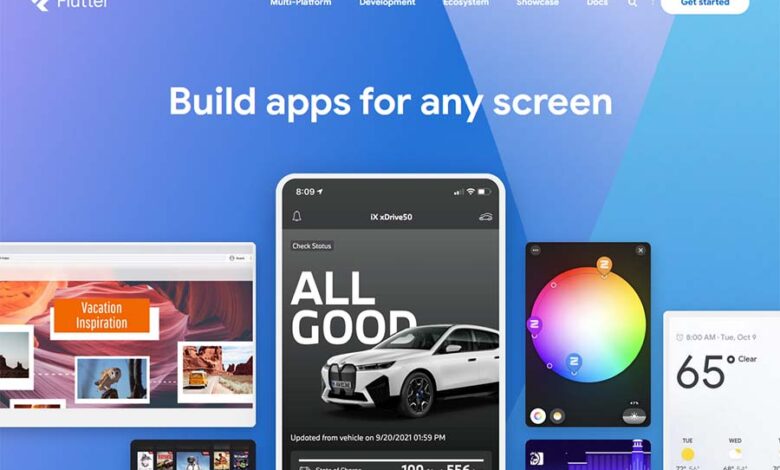
What Is Flutter?
Flutter is one of the more exciting user interface (UI) software development kits (SDKs) we’ve seen in recent years. Flutter offers developers one of the easiest toolkits for building apps across mobile and desktop platforms from the same source code. Keep reading to learn more about Flutter, its benefits, and what you can use it for.
Flutter Explained
 Flutter is not an app framework like Angular or React. Rather, it’s a complete SDK that packs all the tools a developer needs to build native apps with a single code base. With it, developers can create beautiful UIs and develop and prototype advanced apps faster. The SDK is specifically optimized for 2D mobile apps.
Flutter is not an app framework like Angular or React. Rather, it’s a complete SDK that packs all the tools a developer needs to build native apps with a single code base. With it, developers can create beautiful UIs and develop and prototype advanced apps faster. The SDK is specifically optimized for 2D mobile apps.
While Flutter itself is easy to learn, developers who use it need a basic understanding of the programming language Dart, which was created to make mobile apps faster. Dart is newer compared to other programming languages, and so it’s not something that every developer has picked up.
Flutter enables developer teams to build apps for mobile, desktop, and web all with the same toolkit, which can streamline app deployment and lower maintenance costs. Flutter was first launched in 2017 and is maintained by Google and a large community of developers.
In addition to Android and iOS, Flutter supports Windows, macOS, Linux, and web platforms.
What is Flutter – Benefits
Flutter was designed to be accessible to developers across mobile platforms. Over time, it has expanded to desktop and web platforms as well. Here are some of the key benefits it offers.
Cross Platform
 As noted, Flutter lets developers use the same code base for developing apps across platforms. For developers working on apps across platforms, this can be a big time saver and can reduce the overall cost of building an app.
As noted, Flutter lets developers use the same code base for developing apps across platforms. For developers working on apps across platforms, this can be a big time saver and can reduce the overall cost of building an app.
Top Performance
Flutter is one of the fastest mobile SDKs around. Because it uses Dart, it enables apps to communicate fast and effectively with platforms without the need for widgets and other components ensuring a fast load.
Easy Deployment
Flutter has features like hot reload that make it easier for developers to view changes when building apps and spot errors. This can help them improve deployment times.
Can Reduce Testing Time
It comes with built-in widgets and other features that can reduce the incidence of compatibility errors when building an app. This, in turn, could mean the need for less testing.
What is Flutter – Limitations
While Flutter is easy to use, for native mobile app projects it requires knowledge of Dart, a programming language that not all developers know. However, Dart is considered easy to learn and it has become increasingly important in the last few years.
Another potential limitation is that some developers may use other SDKs for creating apps for iOS platforms. In other words, it may not always be the go-to choice for iOS developers.
Flutter Usage Examples
Flutter powers several Google Assistant apps—no surprise there since it was developed by Google. More impressively, it powers ecommerce giant Alibaba’s Xianyu app. This app enables users to connect with friends and sell second-hand goods—everything from shoes to cars. Over 10 million people use the app daily.
Another notable app created with Flutter is that for the popular Realtor.com real estate website. Flutter is also a popular choice for many mobile apps created by small and medium-sized businesses due to its ease of use for developers who know Dart.
What is Flutter – The Bottom Line
While Flutter is not a mobile app development framework in the proper sense of the word, it’s a powerful SDK that enables developers to create cross-platform apps without any hassle. While some may consider it Google-centric, it’s an effective choice for many developers who want to complete their project fast and use resources effectively.
Additional Flutter Resources
- Flutter Dev – Flutter is supported and used by Google, trusted by well-known brands around the world, and maintained by a community of global developers.
- Flutter Samples – A curated list of Flutter samples and apps
- Flutter Cookbook – contains recipes that demonstrate how to solve common problems while writing Flutter apps.
- Flutter Learning – Choose your skill level to start your journey from resources through learning activities.
- Flutter Latest News -latest articles on Flutter Development
